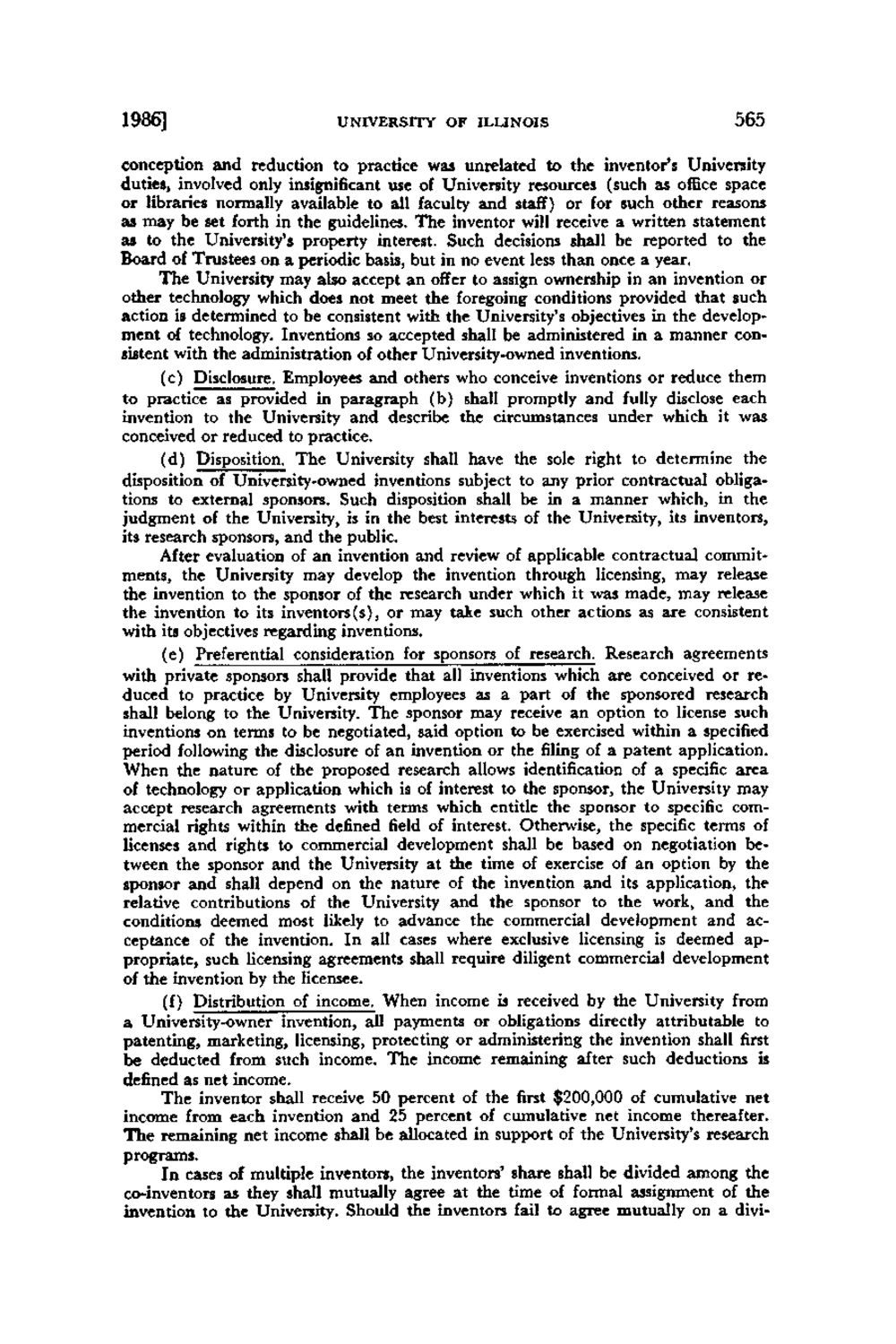| |
| |
Caption: Board of Trustees Minutes - 1986
This is a reduced-resolution page image for fast online browsing.

EXTRACTED TEXT FROM PAGE:
1986] UNIVERSITY OF ILLINOIS 565 conception and reduction to practice was unrelated to the inventor's University duties, involved only insignificant use of University resources (such as office space or libraries normally available to all faculty and staff) or for such other reasons as may be set forth in the guidelines. The inventor will receive a written statement as to the University's property interest. Such decisions shall be reported to the Board of Trustees on a periodic basis, but in no event less than once a year. The University may also accept an offer to assign ownership in an invention or other technology which does not meet the foregoing conditions provided that such action is determined to be consistent with the University's objectives in the development of technology. Inventions so accepted shall be administered in a manner consistent with the administration of other University-owned inventions. (c) Disclosure. Employees and others who conceive inventions or reduce them to practice as provided in paragraph (b) shall promptly and fully disclose each invention to the University and describe the circumstances under which it was conceived or reduced to practice. (d) Disposition. The University shall have the sole right to determine the disposition of University-owned inventions subject to any prior contractual obligations to external sponsors. Such disposition shall be in a manner which, in the judgment of the University, is in the best interests of the University, its inventors, its research sponsors, and the public. After evaluation of an invention and review of applicable contractual commitments, the University may develop the invention through licensing, may release the invention to the sponsor of the research under which it was made, may release the invention to its inventors(s), or may take such other actions as are consistent with its objectives regarding inventions. (e) Preferential consideration for sponsors of research. Research agreements with private sponsors shall provide that all inventions which are conceived or reduced to practice by University employees as a part of the sponsored research shall belong to the University. The sponsor may receive an option to license such inventions on terms to be negotiated, said option to be exercised within a specified period following the disclosure of an invention or the filing of a patent application. When the nature of the proposed research allows identification of a specific area of technology or application which is of interest to the sponsor, the University may accept research agreements with terms which entitle the sponsor to specific commercial rights within the defined field of interest. Otherwise, the specific terms of licenses and rights to commercial development shall be based on negotiation between the sponsor and the University at the time of exercise of an option by the sponsor and shall depend on the nature of the invention and its application, the relative contributions of the University and the sponsor to the work, and the conditions deemed most likely to advance the commercial development and acceptance of the invention. In all cases where exclusive licensing is deemed appropriate, such licensing agreements shall require diligent commercial development of the invention by the licensee. (f) Distribution of income. When income is received by the University from a University-owner invention, all payments or obligations directly attributable to patenting, marketing, licensing, protecting or administering the invention shall first be deducted from such income. The income remaining after such deductions is defined as net income. T h e inventor shall receive 50 percent of the first $200,000 of cumulative net income from each invention and 25 percent of cumulative net income thereafter. T h e remaining net income shall be allocated in support of the University's research programs. In cases of multiple inventors, the inventors' share shall be divided among the co-inventors as they shall mutually agree at the time of formal assignment of the invention to the University. Should the inventors fail to agree mutually on a divi-
| |